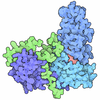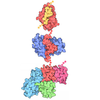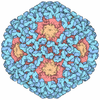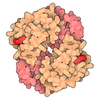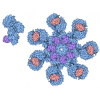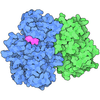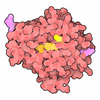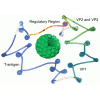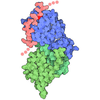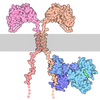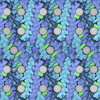+ データを開く
データを開く
- 基本情報
基本情報
| 登録情報 | データベース: PDB / ID: 8j8n | ||||||
|---|---|---|---|---|---|---|---|
| タイトル | Structure of p53 DNA-binding domain and ZNF568 KRAB domain complex | ||||||
 要素 要素 |
| ||||||
 キーワード キーワード | PROTEIN BINDING / p53 DBD / ZNF 568 KRAB / p53-dependent glycosis / mitochondrial respiration | ||||||
| 機能・相同性 |  機能・相同性情報 機能・相同性情報Loss of function of TP53 in cancer due to loss of tetramerization ability / Regulation of TP53 Expression / negative regulation of helicase activity / signal transduction by p53 class mediator / negative regulation of G1 to G0 transition / negative regulation of glucose catabolic process to lactate via pyruvate / Transcriptional activation of cell cycle inhibitor p21 / regulation of intrinsic apoptotic signaling pathway by p53 class mediator / negative regulation of pentose-phosphate shunt / ATP-dependent DNA/DNA annealing activity ...Loss of function of TP53 in cancer due to loss of tetramerization ability / Regulation of TP53 Expression / negative regulation of helicase activity / signal transduction by p53 class mediator / negative regulation of G1 to G0 transition / negative regulation of glucose catabolic process to lactate via pyruvate / Transcriptional activation of cell cycle inhibitor p21 / regulation of intrinsic apoptotic signaling pathway by p53 class mediator / negative regulation of pentose-phosphate shunt / ATP-dependent DNA/DNA annealing activity / Activation of NOXA and translocation to mitochondria / regulation of cell cycle G2/M phase transition / regulation of fibroblast apoptotic process / intrinsic apoptotic signaling pathway in response to hypoxia / oligodendrocyte apoptotic process / negative regulation of miRNA processing / positive regulation of thymocyte apoptotic process / oxidative stress-induced premature senescence / regulation of tissue remodeling / glucose catabolic process to lactate via pyruvate / positive regulation of mitochondrial membrane permeability / positive regulation of programmed necrotic cell death / mRNA transcription / bone marrow development / circadian behavior / regulation of mitochondrial membrane permeability involved in apoptotic process / germ cell nucleus / RUNX3 regulates CDKN1A transcription / TP53 regulates transcription of additional cell cycle genes whose exact role in the p53 pathway remain uncertain / TP53 Regulates Transcription of Death Receptors and Ligands / Activation of PUMA and translocation to mitochondria / regulation of DNA damage response, signal transduction by p53 class mediator / histone deacetylase regulator activity / negative regulation of glial cell proliferation / Regulation of TP53 Activity through Association with Co-factors / negative regulation of neuroblast proliferation / T cell lineage commitment / mitochondrial DNA repair / Formation of Senescence-Associated Heterochromatin Foci (SAHF) / ER overload response / B cell lineage commitment / thymocyte apoptotic process / TP53 Regulates Transcription of Caspase Activators and Caspases / negative regulation of mitophagy / cardiac septum morphogenesis / negative regulation of DNA replication / entrainment of circadian clock by photoperiod / PI5P Regulates TP53 Acetylation / negative regulation of telomere maintenance via telomerase / Zygotic genome activation (ZGA) / positive regulation of release of cytochrome c from mitochondria / Association of TriC/CCT with target proteins during biosynthesis / necroptotic process / TP53 Regulates Transcription of Genes Involved in Cytochrome C Release / TFIID-class transcription factor complex binding / rRNA transcription / SUMOylation of transcription factors / TP53 regulates transcription of several additional cell death genes whose specific roles in p53-dependent apoptosis remain uncertain / intrinsic apoptotic signaling pathway by p53 class mediator / T cell proliferation involved in immune response / negative regulation of reactive oxygen species metabolic process / positive regulation of execution phase of apoptosis / Transcriptional Regulation by VENTX / replicative senescence / general transcription initiation factor binding / cellular response to UV-C / intrinsic apoptotic signaling pathway in response to endoplasmic reticulum stress / cellular response to actinomycin D / positive regulation of RNA polymerase II transcription preinitiation complex assembly / neuroblast proliferation / intrinsic apoptotic signaling pathway in response to DNA damage by p53 class mediator / response to X-ray / type II interferon-mediated signaling pathway / hematopoietic stem cell differentiation / Pyroptosis / chromosome organization / viral process / embryonic organ development / somitogenesis / TP53 Regulates Transcription of Genes Involved in G1 Cell Cycle Arrest / glial cell proliferation / hematopoietic progenitor cell differentiation / core promoter sequence-specific DNA binding / negative regulation of stem cell proliferation / cellular response to glucose starvation / cis-regulatory region sequence-specific DNA binding / mitophagy / negative regulation of fibroblast proliferation / positive regulation of cardiac muscle cell apoptotic process / positive regulation of intrinsic apoptotic signaling pathway / tumor necrosis factor-mediated signaling pathway / negative regulation of proteolysis / Regulation of TP53 Activity through Acetylation / mitotic G1 DNA damage checkpoint signaling / gastrulation / 14-3-3 protein binding / response to salt stress / MDM2/MDM4 family protein binding / cardiac muscle cell apoptotic process / transcription repressor complex 類似検索 - 分子機能 | ||||||
| 生物種 |  Homo sapiens (ヒト) Homo sapiens (ヒト) | ||||||
| 手法 | 電子顕微鏡法 / 単粒子再構成法 / クライオ電子顕微鏡法 / 解像度: 9.02 Å | ||||||
 データ登録者 データ登録者 | Han, C.W. | ||||||
| 資金援助 |  韓国, 1件 韓国, 1件
| ||||||
 引用 引用 |  ジャーナル: Int J Biol Macromol / 年: 2024 ジャーナル: Int J Biol Macromol / 年: 2024タイトル: Influence of the interaction between p53 and ZNF568 on mitochondrial oxidative phosphorylation. 著者: Chang Woo Han / Mi Suk Jeong / Se Bok Jang /  要旨: The tumor suppressor p53 plays important roles in suppressing the development and progression of cancer by responding to various stress signals. In addition, p53 can regulate the metabolic pathways ...The tumor suppressor p53 plays important roles in suppressing the development and progression of cancer by responding to various stress signals. In addition, p53 can regulate the metabolic pathways of cancer cells by regulating energy metabolism and oxidative phosphorylation. Here, we present a mechanism for the interaction between p53 and ZNF568. Initially, we used X-ray crystallography to determine the irregular loop structure of the ZNF568 KRAB domain; this loop plays an important role in the interaction between p53 and ZNF568. In addition, Cryo-EM was used to examine how the p53 DBD and ZNF568 KRAB domains bind together. The function of ZNF568 on p53-mediated mitochondrial respiration was confirmed by measuring glucose consumption and lactate production. These findings show that ZNF568 can reduce p53-mediated mitochondrial respiratory activity by binding to p53 and inhibiting the transcription of SCO2. SIGNIFICANCE: ZNF568 can directly bind to the p53 DBD and transcriptionally regulate the SCO2 gene. SCO2 transcriptional regulation by interaction between ZNF568 and p53 may regulate the balance between mitochondrial respiration and glycolysis. | ||||||
| 履歴 |
|
- 構造の表示
構造の表示
| 構造ビューア | 分子:  Molmil Molmil Jmol/JSmol Jmol/JSmol |
|---|
- ダウンロードとリンク
ダウンロードとリンク
- ダウンロード
ダウンロード
| PDBx/mmCIF形式 |  8j8n.cif.gz 8j8n.cif.gz | 207.5 KB | 表示 |  PDBx/mmCIF形式 PDBx/mmCIF形式 |
|---|---|---|---|---|
| PDB形式 |  pdb8j8n.ent.gz pdb8j8n.ent.gz | 表示 |  PDB形式 PDB形式 | |
| PDBx/mmJSON形式 |  8j8n.json.gz 8j8n.json.gz | ツリー表示 |  PDBx/mmJSON形式 PDBx/mmJSON形式 | |
| その他 |  その他のダウンロード その他のダウンロード |
-検証レポート
| 文書・要旨 |  8j8n_validation.pdf.gz 8j8n_validation.pdf.gz | 1.2 MB | 表示 |  wwPDB検証レポート wwPDB検証レポート |
|---|---|---|---|---|
| 文書・詳細版 |  8j8n_full_validation.pdf.gz 8j8n_full_validation.pdf.gz | 1.2 MB | 表示 | |
| XML形式データ |  8j8n_validation.xml.gz 8j8n_validation.xml.gz | 55.4 KB | 表示 | |
| CIF形式データ |  8j8n_validation.cif.gz 8j8n_validation.cif.gz | 77.9 KB | 表示 | |
| アーカイブディレクトリ |  https://data.pdbj.org/pub/pdb/validation_reports/j8/8j8n https://data.pdbj.org/pub/pdb/validation_reports/j8/8j8n ftp://data.pdbj.org/pub/pdb/validation_reports/j8/8j8n ftp://data.pdbj.org/pub/pdb/validation_reports/j8/8j8n | HTTPS FTP |
-関連構造データ
| 関連構造データ |  36075MC M: このデータのモデリングに利用したマップデータ C: 同じ文献を引用 ( |
|---|---|
| 類似構造データ | 類似検索 - 機能・相同性  F&H 検索 F&H 検索 |
- リンク
リンク
- 集合体
集合体
| 登録構造単位 | 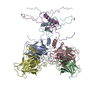
|
|---|---|
| 1 |
|
- 要素
要素
| #1: タンパク質 | 分子量: 13940.639 Da / 分子数: 2 / 由来タイプ: 組換発現 / 由来: (組換発現)  Homo sapiens (ヒト) / 遺伝子: ZNF568 / 発現宿主: Homo sapiens (ヒト) / 遺伝子: ZNF568 / 発現宿主:  #2: タンパク質 | 分子量: 22658.805 Da / 分子数: 4 / Fragment: DNA binding domain / 由来タイプ: 組換発現 / 由来: (組換発現)  Homo sapiens (ヒト) / 遺伝子: TP53, P53 / 発現宿主: Homo sapiens (ヒト) / 遺伝子: TP53, P53 / 発現宿主:  #3: 化合物 | ChemComp-ZN / 研究の焦点であるリガンドがあるか | Y | Has protein modification | N | |
|---|
-実験情報
-実験
| 実験 | 手法: 電子顕微鏡法 |
|---|---|
| EM実験 | 試料の集合状態: PARTICLE / 3次元再構成法: 単粒子再構成法 |
- 試料調製
試料調製
| 構成要素 | 名称: The complex of p53 DNA binding domain and ZNF568 KRAB domain タイプ: COMPLEX / Entity ID: #1-#2 / 由来: RECOMBINANT |
|---|---|
| 分子量 | 値: 0.126 MDa / 実験値: YES |
| 由来(天然) | 生物種:  Homo sapiens (ヒト) Homo sapiens (ヒト) |
| 由来(組換発現) | 生物種:  |
| 緩衝液 | pH: 7.8 |
| 試料 | 包埋: NO / シャドウイング: NO / 染色: NO / 凍結: YES |
| 試料支持 | 詳細: 22mA / グリッドの材料: GOLD / グリッドのサイズ: 200 divisions/in. / グリッドのタイプ: Quantifoil R2/2 |
| 急速凍結 | 凍結剤: NITROGEN |
- 電子顕微鏡撮影
電子顕微鏡撮影
| 顕微鏡 | モデル: TFS GLACIOS |
|---|---|
| 電子銃 | 電子線源:  FIELD EMISSION GUN / 加速電圧: 200 kV / 照射モード: FLOOD BEAM FIELD EMISSION GUN / 加速電圧: 200 kV / 照射モード: FLOOD BEAM |
| 電子レンズ | モード: DARK FIELD / 最大 デフォーカス(公称値): 3000 nm / 最小 デフォーカス(公称値): 2000 nm |
| 撮影 | 電子線照射量: 40 e/Å2 フィルム・検出器のモデル: FEI FALCON III (4k x 4k) |
- 解析
解析
| ソフトウェア |
| ||||||||||||||||||||||||
|---|---|---|---|---|---|---|---|---|---|---|---|---|---|---|---|---|---|---|---|---|---|---|---|---|---|
| CTF補正 | 詳細: ZNF568 KRAB used PDB ID 7W5Q p53 DBD used PDB ID 7DVD タイプ: PHASE FLIPPING AND AMPLITUDE CORRECTION | ||||||||||||||||||||||||
| 3次元再構成 | 解像度: 9.02 Å / 解像度の算出法: FSC 0.143 CUT-OFF / 粒子像の数: 76698 / 対称性のタイプ: POINT | ||||||||||||||||||||||||
| 精密化 | 立体化学のターゲット値: CDL v1.2 | ||||||||||||||||||||||||
| 拘束条件 |
|
 ムービー
ムービー コントローラー
コントローラー



 PDBj
PDBj
